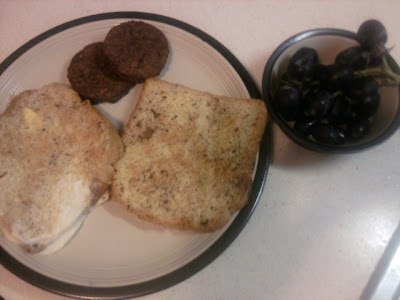Here is a great breakfast idea for a Saturday morning before setting off to take the kids to soccer or before hitting the mall for a day of Christmas shopping. Or maybe for a lazy Sunday morning before enjoying a cup of coffee and the crossword puzzle. Or even before work or school during the week if you are a little more ambitious!
 |
| French toast, sausage patties, and fruit! |
I used cinnamon raisin bread to make french toast, using a couple eggs mixed with a splash of water and vanilla. I used my bread maker for the cinnamon raisin bread, but it would work just as well with store bought bread. I love having a bread maker! It is so easy to use (literally all you do is put the ingredients in and set the timer!), it saves money, and fresh bread is just so much better! Plus, it can be used for other things, such as pizza dough and cinnamon roll dough! I really enjoy the pizza dough, but haven't given the cinnamon rolls a shot yet!
Along with my french toast I made some meat-free breakfast sausage patties. I love the Morning Star maple flavored ones. The regular flavored ones are a bit to salty for my taste, so the maple ones are more toned down. Of course you could also use traditional sausage patties if that's what you prefer! I also had a side of grapes, to start off my fruit servings for the day!
Cheers,
Brittney




































